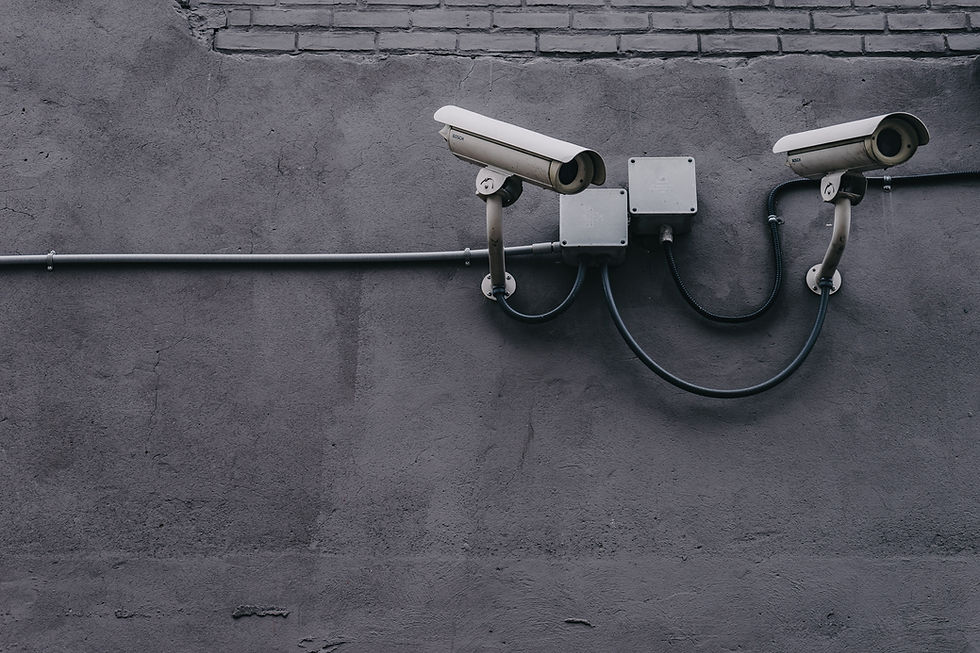How AI Is Transforming Modern Security Surveillance
- Vanshika Thareja

- Jun 25
- 4 min read
Introduction
First, recent projections estimate that the AI-powered video surveillance market will expand from approximately US $5.98 billion in 2025 to around US $11.8 billion by 2030, reflecting a compound annual growth rate of about 14.5%. Meanwhile, the wider AI surveillance sector is anticipated to grow from US $16.6 billion in 2025 to US $41.3 billion by 2034, with a CAGR of approximately 21.3%. Clearly, what was once a niche niche technology is now rapidly becoming mainstream across security systems in various industries.

Artificial Intelligence is transforming video surveillance from a reactive system into a proactive, intelligent security network. As cities, campuses, and businesses face increasing security demands, AI-enabled systems are proving indispensable—enhancing monitoring, automating threat detection, and enabling rapid, data-driven responses.
Smarter Monitoring in Real Time
AI turns traditional, passive security cameras into intelligent monitoring agents. Using deep learning, these systems can detect suspicious behavior—like loitering, forced entry, or visible weapons—in real time and trigger immediate alerts. Instead of relying on operators to manually spot threats, security teams receive context-aware notifications, leading to faster, more accurate responses than conventional CCTV systems ever could.
Automated Threat Detection and Forensic Analytics
AI surveillance systems can now:
Recognize faces and license plates
Estimate crowd density
Detect aggressive behavior or weapons
These capabilities go beyond monitoring—they index and tag video feeds with metadata, enabling investigators to search for specific criteria (like a person’s face or a vehicle's number plate) in seconds rather than hours. This dramatically streamlines post-incident investigations and enhances operational efficiency.
Upgrading Legacy Infrastructure
Organizations don’t need to replace entire camera networks to benefit from AI. Platforms like those from Coram AI allow existing IP cameras to be retrofitted with smart surveillance capabilities. This extends the lifespan of current infrastructure while delivering real-time threat analysis and reducing the burden on human monitoring teams.
Proactive Security with Intelligent Search
AI brings searchable timelines to surveillance. Security personnel can enter descriptions like “person wearing red cap” and retrieve the exact footage instantly. Features like Coram AI’s "Discover" mode enable advanced searches across time and location, allowing rapid, targeted reviews during investigations or active threats.
Scaling Across Cities and Campuses
Large-scale deployment is becoming the norm, particularly in smart city initiatives. From tracking traffic violations to monitoring public safety, AI systems manage thousands of feeds simultaneously. Centralized command centers receive real-time data streams from distributed cameras, allowing them to manage entire urban environments with unprecedented visibility and control.
Precision Alerts and Smart Notifications
Modern AI surveillance has moved far beyond motion detection. Today’s systems categorize events by type—such as weapon visibility, unusual behavior, or restricted area breach. This specificity reduces false positives, helping security teams focus on genuine threats and improving decision-making under pressure.
Privacy, Ethics, and Regulation
Despite the benefits, the growing use of AI in surveillance raises serious privacy and ethical questions. Concerns include:
Facial recognition and consent
Data retention policies
Potential misuse of sensitive information
As a response, frameworks like the General Data Protection Regulation (GDPR) and similar laws worldwide are shaping how AI surveillance is deployed, demanding transparency, data protection, and responsible AI governance.
Integration with IoT and Access Control
AI doesn’t work in isolation. Integrated with IoT ecosystems, AI-powered surveillance can interface with access control systems to restrict or grant entry based on real-time assessments. For example, an airport might deny entry to an individual flagged by facial recognition or movement analysis—adding another layer of automated, intelligent protection.
Edge AI: Speed and Privacy Combined
Edge computing brings processing directly to the surveillance device. Instead of sending data to a central server, AI algorithms work locally, minimizing latency and enhancing privacy. This setup is especially useful in remote locations or high-risk zones with limited connectivity or heightened security needs.
What’s Next: Predictive and Preventive Surveillance
Looking ahead, the next generation of AI surveillance will move from reactive to predictive. Innovations include:
Multi-sensor fusion (combining data from cameras, sensors, and audio feeds)
Behavioral pattern recognition
Predictive analytics to forecast security risks before they escalate
This will allow security teams to intervene before incidents occur, redefining what’s possible in public safety and asset protection.
FAQs
Can AI surveillance help reduce crime?Yes. Real-time threat detection, proactive alerts, and faster incident response all serve as deterrents and can contribute to a reduction in criminal activity.
Is AI surveillance legally compliant?It must be. Systems are required to follow regulations like GDPR in Europe and similar frameworks elsewhere, ensuring ethical deployment and data protection.
How does AI surveillance differ from traditional systems?Traditional systems rely on human monitoring. AI systems use algorithms to continuously analyze video data, detect anomalies, and alert personnel to potential threats in real time.
Conclusion
AI is revolutionizing the surveillance landscape. By enhancing monitoring, automating threat detection, and enabling smarter integrations with existing infrastructure, AI surveillance is helping organizations of all sizes become more secure, responsive, and efficient. However, as the technology advances, the need for ethical oversight and regulatory compliance becomes even more critical.


Comments